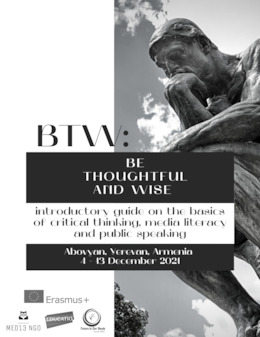Toolbox — For Training and Youth Work
All new tools in your inbox: Be the first to know about new tools for learning with our e-mail notifications.
Manual
BTW: Be Thoughtful and Wise
This guide on the basics of critical thinking, media literacy and public speaking gives theoretical information and practical pieces of advice on how to improve mentioned competencies and also contains examples of public speeches with their analysis.
Aims of the tool
- to increase awareness about critical thinking and give practical tools for its improvement;
- to guide in creating mind-maps;
- to educate about cognitive biases and thus contribute to declining their influence;
- to inform about different methods of self- and group reflection;
- to develop the skill of media literacy (namely, detecting fake photos, recognizing misleading data visualization tactics, checking incoming information);
- to give an understanding of the importance of rhetoric;
- to advise how to create powerful public speech.
Description of the tool
The modern world is a world of information. We are in a constant data flow, which we receive from people around us, from the media and other Internet resources. The abundance and variety of sources generate contradictory information. Unfortunately, this information is often not reliable and credible. Its distortion can be caused by various reasons – from ignorance or irresponsibility of the informant to deliberate control of the audience's consciousness. In any case, if we don't want to be misled and manipulated, we need to learn how to analyze information, separate facts from interpretations and draw conclusions. In other words, we need to develop media literacy and, more broadly, critical thinking.
There are three chapters in this guide.
The first one is devoted to critical thinking and, mainly, cognitive biases — subconscious errors in thinking that lead people to misinterpret information from the world. And since the initial step in overcoming biases (or, more correctly, decreasing their influence) is to recognize them, we describe some of the common biases there. Then, because the competence of critical thinking includes common erudition, we provide a step-by-step guide on how to make mind maps which are a powerful tool for the work with incoming information, if we want to understand and memorize it better. Also, this chapter contains a description of some games and reflection methods. They make people answer questions, analyze their own emotions and thoughts, draw conclusions, create strategies, etc, and it could become useful additional activities to develop critical thinking.
The second chapter is about media literacy. It explains how to build upon this skill in general and, particularly, how to check data, detect fake photos, and recognize misleading charts and infographics.
The third chapter focuses on public speaking. A well-prepared public speech is one of the most powerful tools for persuading the audience. Unfortunately, it is not always the ideas that sound from behind the stands that are useful to the public. To avoid being manipulated, you have to be able to identify the rhetorical means by which it is constructed. And the best way to learn them is to put them into practice by preparing your public speech. So, the third part of the brochure tells about the importance of rhetoric and debates, advises on how to build a strong argument, contains tips for speaking in a front of an audience, and sets of examples of different rhetorical devices, which help to create an eloquent and persuasive speech. We also included some concrete texts — speeches that were written by participants of the training course «Be Thoughtful and Wise» — and provided them with analysis (defined the problem, topic, goal, composition, etc).
So, given all these considerations, we expect the following learning outcomes:
- awareness about critical thinking and cognitive biases;
- knowledge about media literacy;
- understanding of rhetoric and public speaking.
In conclusion, we’d like to underline that this guide contains both theoretical and practical information, which makes it a good tool for learning.
Available downloads:
Disclaimer
SALTO cannot be held responsible for the inappropriate use of these training tools. Always adapt training tools to your aims, context, target group and to your own skills! These tools have been used in a variety of formats and situations. Please notify SALTO should you know about the origin of or copyright on this tool.
Tool overview

http://toolbox.salto-youth.net/3108
This tool addresses
Personal Development, Peer education, Evaluation
It is recommended for use in:
Training and Networking
Meetings between young people and decision-makers
Behind the tool
The tool was created by
The tool was created by participants of the Erasmus+ Training Course "BTW: Be Thoughtful and Wise" 4 - 13 December 2021 in Armenia, Abovyan
in the context of
The tool was created during the Erasmus+ Training Course "BTW: Be Thoughtful and Wise" 4 - 13 December 2021 in Armenia, Abovyan
The tool was published to the Toolbox by
Vladimir Kozachun (on 8 January 2022)
and last modified
29 December 2021
Comments
No comments have been posted yet.
If you want to comment on this tool, you need to be signed in with your MySALTO account. Sign in now